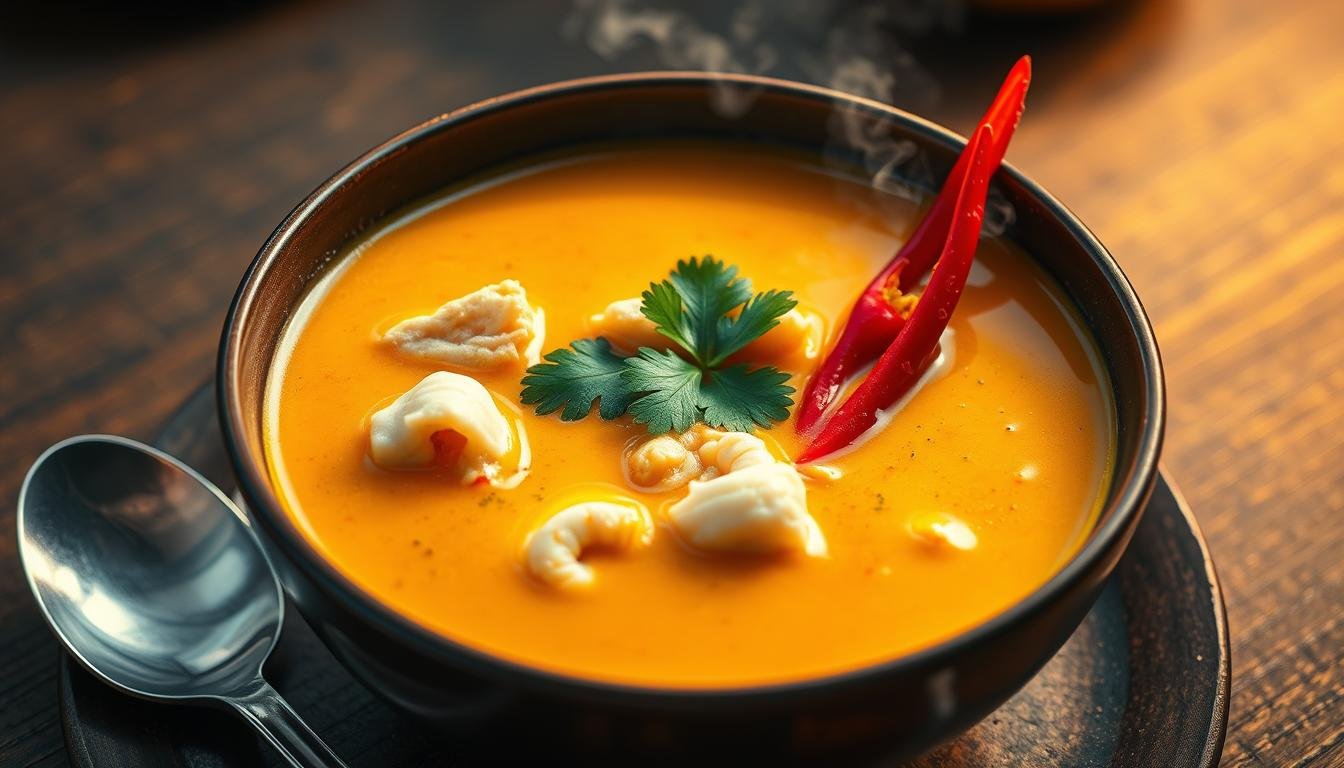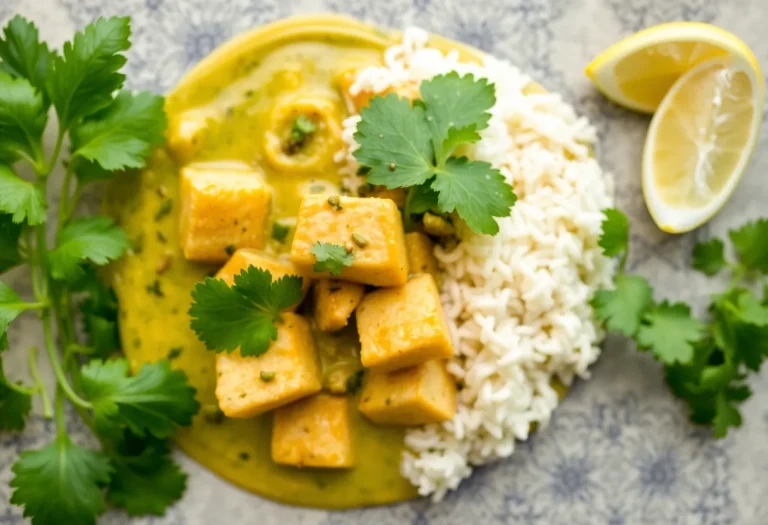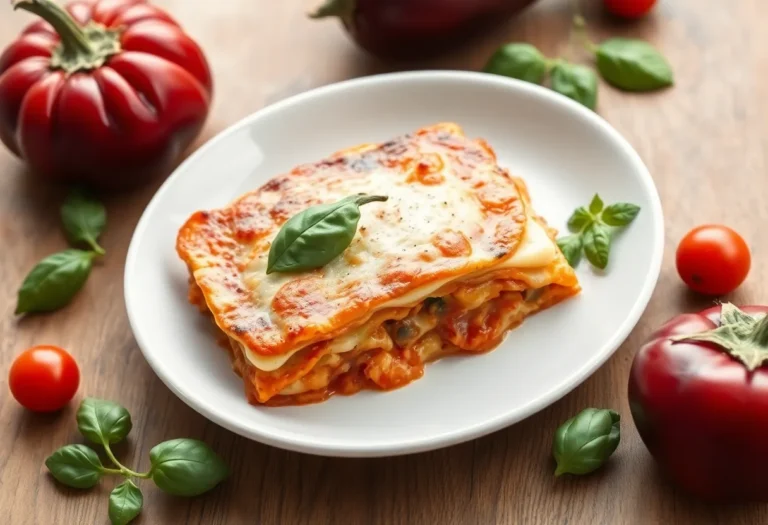Thai Coconut Curry Soup
Ever wondered why Thai coconut curry soup is so tasty? It’s more than just food; it’s a journey to Thailand’s vibrant streets.
This dish mixes creamy coconut milk with spices and herbs. It’s a mix that makes every bite unforgettable. It’s a story of Thai cooking traditions passed down through generations.
Whether you love food or just want to try something new, this guide is for you. You’ll learn how to make the perfect Thai coconut curry soup. Get ready for a flavor adventure that combines heat, sweetness, and depth in every bite.
Key Takeaways
- Discover the authentic roots of Thai coconut curry soup
- Learn how coconut milk creates the signature creamy texture
- Understand the delicate balance of flavors in Thai cuisine
- Explore traditional cooking techniques
- Prepare to transform your home cooking skills
Quick Recomendation: Our blog is full of useful information to inspire you. If you are seeking a healthy way to prepare your meals, we recommend this Keto product
What Makes Thai Coconut Curry Soup Special
Thai Coconut Curry Soup is a true culinary masterpiece. It awakens your taste buds with its deep flavors. The magic starts with a vibrant red curry paste that bursts with taste in every spoonful.
This soup is special because of its perfect balance of flavors. The creamy coconut milk adds a smooth, rich base. It perfectly matches the spicy kick of the red curry paste. Fresh vegetables add texture and nutrition, making it satisfying and versatile.
The beauty of Thai Coconut Curry Soup is how it blends sweet, sour, salty, and spicy flavors. Each ingredient works together to create a harmonious taste that feels like a trip to Thailand. It’s perfect for spice lovers and those who prefer milder flavors.
This soup is not only delicious but also nutritious. It combines red curry paste with colorful vegetables for a meal that’s both nourishing and exciting.
Essential Ingredients for Perfect Thai Coconut Curry Soup
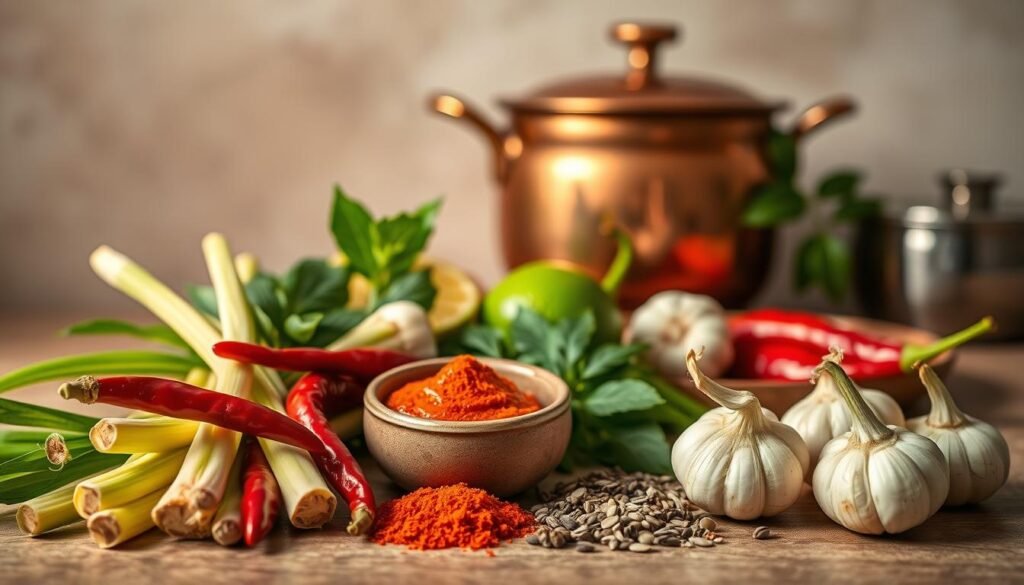
Starting an authentic Thai coconut curry soup means picking the right ingredients. Your journey begins with three key aromatics: lemongrass, galangal, and kaffir lime leaves. These are not just simple additions but the heart of your dish.
Lemongrass adds a citrusy, tangy flavor that balances the richness of coconut milk. When you crush or chop it, it releases a strong fragrance that takes you to Bangkok’s streets. Galangal, a ginger relative, gives a sharp, peppery kick that makes Thai cuisine unique.
Kaffir lime leaves are key for their intense citrus scent. These dark green leaves add a bright, complex flavor to your curry. For the best taste, use fresh ingredients from local Asian markets or specialty stores.
Next, add fresh veggies like bell peppers, Thai chilies, and onions. You can also include proteins like chicken, shrimp, or tofu for a heartier meal. Coconut milk is the creamy base that brings all these flavors together.
Kitchen Tools and Equipment You’ll Need

To make a tasty thai coconut curry soup, you need some key kitchen tools. First, get a big, heavy-bottomed soup pot or Dutch oven. This cookware spreads heat evenly and keeps your ingredients from burning.
A sharp chef’s knife is essential for cutting veggies and proteins well. Choose a quality knife that lets you chop quickly and evenly. Also, use a cutting board with a non-slip surface to stay stable while chopping.
Think about getting some extra tools to make your soup-making better. A wooden spoon is great for stirring without scratching your pot. A ladle makes serving your soup easy and clean. An immersion blender can also make your soup smoother if you like it that way.
Tools like a mortar and pestle for grinding spices and making curry paste are nice but not necessary. A measuring cup and spoons help you get the right amounts of ingredients. This ensures your soup tastes just right.
With these tools, you’re all set to make a delicious thai coconut curry soup at home.
Preparing Your Thai Curry Paste From Scratch
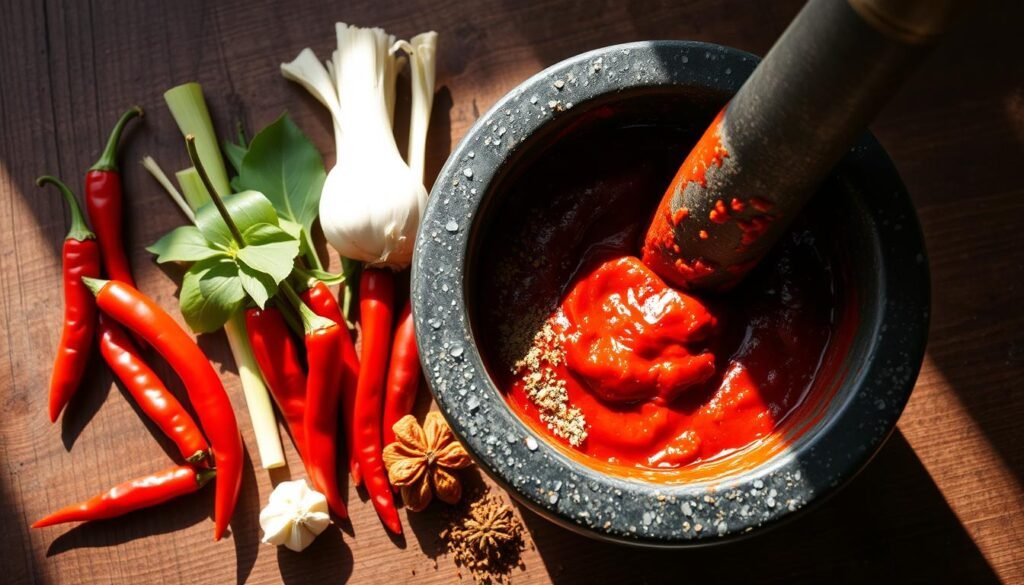
Making your own red curry paste is a big step towards true Thai flavors. It starts with picking the right chili peppers and grinding them to get their full taste. Traditional Thai chefs use a mortar and pestle to mix the ingredients well.
Begin by picking fresh chili peppers that are hot and flavorful. Thai bird’s eye chilies are great for red curry paste. They add heat and depth. If you want it less spicy, remove the seeds. Roasting the chilies before grinding can make them sweeter and less hot.
Next, get fresh ingredients like lemongrass, garlic, shallots, and galangal. A food processor can be a modern substitute for a mortar and pestle. The goal is to make a smooth paste that will make your Thai coconut curry soup taste amazing.
Keep your homemade red curry paste in a sealed container in the fridge. It lasts about a week, so you can make many dishes without starting over. Tip: freeze small parts to keep it longer and have Thai flavors ready when you need them.
How to Choose and Prepare Fresh Aromatics
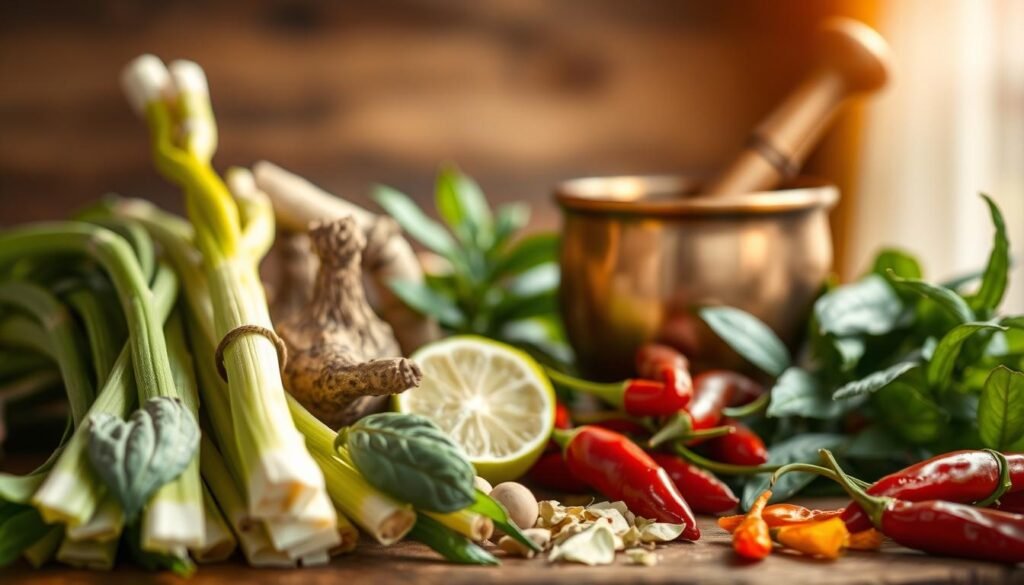
Starting your Thai Coconut Curry Soup journey is all about picking the right aromatics. Lemongrass is key, adding a zesty and woody taste. Choose stalks that are firm, with a pale green to white base. Avoid dry or yellowed ones.
Galangal is another must-have for true Thai flavors. It’s like ginger but with a sharper, peppery taste. Look for galangal that’s heavy and has smooth skin. It should snap when bent and smell strongly of spice.
Kaffir lime leaves add a unique citrusy and floral touch. They should be dark green, glossy, and flexible. When you crush them, they should smell powerful and fresh.
Storing these aromatics right is important. Wrap lemongrass and galangal in damp paper towels and keep them in the fridge. Kaffir lime leaves go in a sealed bag in the freezer. This way, your Thai Coconut Curry Soup will be full of real, lively flavors.
Step-by-Step Thai Coconut Curry Soup Recipe
To make a tasty Thai coconut curry soup, start by getting your ingredients ready. Heat a big pot over medium heat and add a bit of oil. Then, sauté minced garlic and ginger until they smell great, filling your kitchen with their aroma.
After that, add your homemade curry paste and stir fast to avoid burning. Cook the paste for about 30 seconds. This step makes the flavor richer. Slowly add coconut milk, whisking to make the soup smooth and creamy.
Now, add your broth slowly and let it simmer gently. Add a tablespoon of fish sauce to deepen the umami flavor. Fish sauce adds a salty, savory taste that complements the coconut milk well.
Next, add your protein and veggies and cook until they’re tender but not too soft. The whole cooking time is about 15-20 minutes. Check the taste and add more fish sauce or lime juice if needed.
Your Thai coconut curry soup is now ready to enjoy. Serve it in warm bowls and top with fresh herbs like cilantro or Thai basil. You’ll have a dish that tastes like it came from a Thai restaurant, right in your own home.
Protein Options and Vegetable Combinations
When making your Thai coconut curry soup, choosing the right protein and vegetables is key. Shrimp is a great choice, adding a seafood flavor. Add fresh, plump shrimp in the last few minutes to avoid overcooking.
Chicken and tofu are also good options. Dice chicken into small pieces for even cooking. Tofu is a great choice for vegetarians, soaking up the curry flavors well.
Vegetables add color, nutrition, and texture. Bell peppers, bamboo shoots, and mushrooms are a classic mix. Roasted pumpkin or sweet potato chunks add a unique twist, boosting flavor and nutrition.
Mixing different vegetables adds depth and complexity. Try adding crisp carrots, tender zucchini, and leafy spinach. Cut all vegetables into similar sizes for even cooking and a nice look.
Try different protein and vegetable combinations to find your favorite Thai coconut curry soup. The goal is to balance flavors, textures, and nutrition for a dish that’s both delicious and satisfying.
Serving Suggestions and Garnishing Tips
Make your thai coconut curry soup stand out by focusing on serving and garnishing. The right touch can turn a simple meal into a feast for the eyes and taste buds. It’s all about creating a memorable experience.
Choose the right base for your soup. Jasmine rice is a great choice, soaking up the broth and adding a soft contrast. Rice noodles are also good for a lighter option.
Get creative with garnishes. Use fresh cilantro, green onions, and red chili flakes for color and flavor. A squeeze of lime adds a zesty touch that balances the soup’s creaminess.
Add some crunch with toasted coconut flakes or crushed peanuts. These not only look good but also add a nice texture. For those who like it spicy, have extra chili sauce ready.
Your thai coconut curry soup is now ready to wow your guests. It’s a perfect mix of taste, texture, and looks that will take them on a trip to Thailand.
Conclusion
Making Thai coconut curry soup at home is more than cooking. It’s a journey into flavors and cultures. You’ve discovered how to make a dish that warms and excites your kitchen.
Understanding the right mix of ingredients and mastering curry paste are key. Now, you can make a remarkable Thai coconut curry soup.
This recipe is very flexible. You can try different proteins, veggies, and spice levels each time. Your unique touch makes it special, showing off your taste and creativity.
Don’t be shy to try new things and adjust the recipe to your liking.
This soup is both tasty and nutritious. It combines fresh ingredients, spices, and coconut milk. Making it at home means you’re choosing a healthier, more mindful way to cook.
It’s not just about the food; it’s about the joy it brings. Share your Thai coconut curry soup with others. It’s a great way to connect and share happiness.
Quick Recomendation: Our blog is full of useful information to inspire you. If you are seeking a healthy way to prepare your meals, we recommend this Keto product
